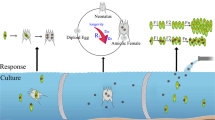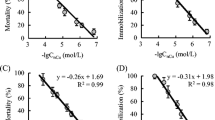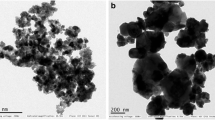Abstract
The present study aims at investigating the potential impacts of the nC60 complex with atrazine on the development of Japanese medaka (Oryzias latipes) embryos and chronic toxicity to D. magna. Although exposure to nC60 below 8 mg/L had no effects on the hatching rate of medaka embryos, it increased the deformity of hatched larvae. Moreover, the presence of nC60 significantly increased the hatching time of the embryos exposed to atrazine. 14-day exposure of D. magna to nC60 significantly reduced offspring production even at a concentration as low as 0.5 mg/L. This indicates that nC60 is able to reduce the ability of D. magna to produce offspring, and therefore would have an impact on population. For atrazine, no significant difference in offspring production was observed. The nC60 complex with atrazine was also found to significantly decrease the reproduction of D. magna, which was similar to the result of exposure to nC60. These results suggest that nC60 would have potential risks to aquatic organisms. Therefore, much attention should be paid to their associations with other contaminants for fullerene’s risk assessment.
Similar content being viewed by others
References
Kroto H W, Heath J R, O’Brien S C, et al. C60: Buckminsterfullerene. Nature, 1985, 318: 162–163
Giacalone F, Martín N. Fullerene polymers: Synthesis and properties. Chem Rev, 2006, 106: 5136–5190
Bakry R, Vallant R M, Najam-Ul-Haq M, et al. Medicinal applications of fullerenes. Int J Nanomedicine, 2007, 2: 639–649
Yan X M, Shi B Y, Wang D S, et al. The eco-toxic aspects of aqueous nano-C60 fullerenes. Prog Chem, 2008, 20: 422–428
Ruoff R S, Tse D S, Malhotra R, et al. Solubility of C60 in a variety of solvents. J Phys Chem, 1993, 97: 3379–3383
Jia G, Wang H F, Yan L, et al. Cytotoxicity of carbon nanomaterials: Single-wall nanotube, multi-wall nanotube, and fullerene. Environ Sci Technol, 2005, 39: 1378–1383
Gharbi N, Pressac M, Hadchouel M, et al. [60]Fullerene is a powerful antioxidant in vivo with no acute or subacute toxicity. Nano Lett, 2005, 5: 2578–2585
Brant J A, Labille J, Bottero J Y, et al. Characterizing the impact of preparation method on fullerene cluster structure and chemistry. Langmuir, 2006, 22: 3878–3885
Deguchi S, Mukai S, Tsudome M, et al. Facile generation of fullerene nanoparticles by hand-grinding. Adv Mater, 2006, 18: 729–732
Cheng X, Kan A T, Tomson M B. Naphthalene adsorption and desorption from aqueous C60 fullerene. J Chem Eng Data, 2004, 49: 675–683
Fortner J D, Lyon D Y, Sayes C M, et al. C60 in water: Nanocrystal formation and microbial response. Environ Sci Technol, 2005, 39: 4307–4316
Espinasse B, Hotze E M, Wiesner M R. Transport and retention of colloidal aggregates of C60 in porous media: Effects of organic macromolecules, ionic composition, and preparation method. Environ Sci Technol, 2007, 41: 7396–7402
Li Y, Wang Y, Pennell K D, et al. Investigation of the transport and deposition of fullerene (C60) nanoparticles in quartz sands under varying flow conditions. Environ Sci Technol, 2008, 42: 7174–7180
Sayes C M, Fortner J D, Guo W, et al. The differential cytotoxicity of water-soluble fullerenes. Nano Lett, 2004, 4: 1881–1887
Isakovic A, Markovic Z, Todorovic-Markovic B, et al. Distinct cytotoxic mechanisms of pristine versus hydroxylated fullerene. Toxicol Sci, 2006, 91: 173–183
Dhawan A, Taurozzi J S, Pandey A K, et al. Stable colloidal dispersions of C60 fullerenes in water: Evidence for genotoxicity. Environ Sci Technol, 2006, 40: 7394–7401
Lyon D Y, Fortner J D, Sayes C M, et al. Bacterial cell association and antimicrobial activity of a C60 water suspension. Environ Toxicol Chem, 2005, 24: 2757–2762
Lyon D Y, Adams L K, Falkner J C, et al. Antibacterial activity of fullerene water suspensions: Effects of preparation method and particle size. Environ Sci Technol, 2006, 40: 4360–4366
Lovern S B, Klaper R. Daphnia magna mortality when exposed to Titanium dioxide and fullerene (C60) nanoparticles. Environ Toxicol Chem, 2006, 25: 1132–1137
Oberdorster E, Zhu S Q, Blickley T M, et al. Ecotoxicology of carbon-based engineered nanoparticles: Effects of fullerene (C60) on aquatic organisms. Carbon, 2006, 44: 1112–1120
Blickley T M, McClellan-Green P. Toxicity of aqueous fullerene in adult and larval Fundulus heteroclitus. Environ Toxicol Chem, 2008, 27: 1964–1971
Oberdörster E. Manufactured nanomaterials (Fullerenes, C60) induce oxidative stress in the brain of juvenile largemouth bass. Environ Health Perspect, 2004, 112: 1058–1062
Sayes C M, Gobin A M, Ausman K D, et al. Nano-C60 cytotoxicity is due to lipid peroxidation. Biomaterials, 2005, 26: 7587–7595
Isakovic A, Markovic Z, Nikolic N, et al. Inactivation of nanocrystalline C60 cytotoxicity by γ-irradiation. Biomaterials, 2006, 27: 5049–5058
Scrivens W A, Tour J M, Creek K E, et al. Synthesis of 14C-labeled C60, its suspension in water, and its iptake by human keratinocytes. J Am Chem Soc., 1994, 116: 4517–4518
Tong Z H, Bischoff M, Nies L, et al. Impact of fullerene (C60) on a soil microbial community. Environ Sci Technol, 2007, 41: 2985–2991
Sayes C M, Marchione A A, Reed K L, et al. Comparative pulmonary toxicity assessments of C60 water suspensions in rats: Few differences in fullerene toxicity in vivo in contrast to in vitro profiles. Nano Lett, 2007, 7: 2399–2406
Cheng X K, Kan A T, Tomson M B. Uptake and sequestration of naphthalene and 1, 2-dichlorobenzene by C60. J Nanopart Res, 2005, 7: 555–567
Baun A, Sorensen S N, Rasmussen R F, et al. Toxicity and bioaccumulation of xenobiotic organic compounds in the presence of aqueous suspensions of aggregates of nano-C60. Aquat Toxicol, 2008, 86: 379–387
Zhang X Z, Sun H W, Zhang Z Y, et al. Enhanced bioaccumulation of cadmium in carp in the presence of Titanium dioxide nanoparticles. Chemosphere, 2007, 67: 160–166
Yan X M, Shi B Y, Lu J J, et al. Adsorption and desorption of atrazine on carbon nanotubes. J Colloid Interface Sci, 2008, 321: 30–38
Zha J M, Wang Z J. Acute and early life stage toxicity of industrial effluent on Japanese medaka (Oryzias latipes). Sci Total Environ, 2006, 357: 112–119
US. EPA. 10-Day Chronic-Daphnia magna or Daphnia pulex; SOP #2028;1994. http://www.ert.org/products/2028.PDF.
Yamakoshi Y, Umezawa N, Ryu A, et al. Active oxygen species generated from photoexcited fullerene (C60) as potential medicines: O2 −⋅ versus 1O2. J Am Chem Soc, 2003, 125: 12803–12809
Zhu X S, Zhu L, Li Y, et al. Developmental toxicity in zebrafish (Danio rerio) embryos after exposure to manufactured nanomaterials: Buckminsterfullerene aggregates (nC60) and fullerol. Environ Toxicol Chem, 2007, 26: 976–979
Usenko C, Harper S, Tanguay R. Fullerene C60 exposure elicits an oxidative stress response in embryonic zebrafish. Toxicol Appl Pharmacol, 2008, 229: 44–55
Henry T B, Menn F M, Fleming J T, et al. Attributing effects of aqueous C60 nano-aggregates to tetrahydrofuran decomposition products in larval zebrafish by assessment of gene expression. Environ Health Perspect, 2007, 115: 1059–1065
Zhang B, Cho M, Fortner J D, et al. Delineating oxidative processes of aqueous C60 preparations: Role of THF peroxide. Environ Sci Technol, 2009, 43: 108–113
Spurlin T A, Gewirth A A. Effect of C60 on solid supported lipid bilayers. Nano Lett, 2007, 7: 531–535
Fang J S, Lyon D Y, Wiesner M R, et al. Effect of a fullerene water suspension on bacterial phospholipids and membrane phase behavior. Environ Sci Technol, 2007, 41: 2636–2642
Tang Y J J, Ashcroft J M, Chen D, et al. Charge-associated effects of fullerene derivatives on microbial structural integrity and central metabolism. Nano Lett, 2007, 7: 754–760
Lovern S B, Strickler J R, Klaper R. Behavioral and physiological changes in Daphnia magna when exposed to nanoparticle suspensions (Titanium dioxide, nano-C60, and C60HxC70Hx). Environ Sci Technol, 2007, 41: 4465–4470
Author information
Authors and Affiliations
Corresponding author
About this article
Cite this article
Yan, X., Zha, J., Shi, B. et al. In vivo toxicity of nano-C60 aggregates complex with atrazine to aquatic organisms. Chin. Sci. Bull. 55, 339–345 (2010). https://doi.org/10.1007/s11434-009-0702-5
Received:
Accepted:
Published:
Issue Date:
DOI: https://doi.org/10.1007/s11434-009-0702-5




